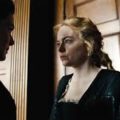
These were not kissin’ cousins. Saoirse Ronan and Margot Robbie go head-to-head in a royal chess game for political, and religious power. Ronan signed on for this role 6 years ago at the age of 18 and has been chomping at the bit to dig her teeth into this elaborate costumed period piece ever since. There have been umpteen Queen Elizabeths played by everyone from Vanessa Redgrave and Cate Blanchette to Helen Mirren.
Mary, widowed very young, was sent to Scotland, out of the way, and away from Elizabeth who some thought would name her young cousin her successor. Not a chance. They were supposed to meet and they do in this movie. But in actuality, that never happened. Director Josie Rourke, (Stage Director of National Theatre Live productions of Saint Joan, Les Liaisons Dangereuses) took liberty with history to stage that scene.
Ronan channels Mary looking stunningly beautiful. She appears frail with delicate features, red hair and piercing blue eyes. But do not be deceived. Ronan shows how this monarch manipulates the men around her to try to get what she wants, but the men use their advantage to manipulate her, too.
Margot Robbie, as Queen Elizabeth, didn’t get to look her pretty self in this one. She had to go through an elaborate process, shaving her eyebrows, changing her hairline, and wearing gobs of face makeup to make her skin look scarred from having had smallpox. Even through her pock marked makeup, and later the stark white face paint, Robbie attempts to channel the Queen of England, but we never stopped seeing her as the actress in this role. It also didn’t help that the majority of the films dwells on Mary since the story is told from her point of view.



Written by Beau Willimon (House of Cards), and based on the book “Queen of Scots: the True Life of Mary Stuart,” the script is sorely lacking. Willimon is well versed in the machinations of political power writing and developing the American version of House of Cards. But here, Queen Elizabeth’s motivations for many of her actions go under explained. Elizabeth is always petulant and angry, forever trying to plan how to hold onto power. The scene where she has hand-crafted a picture out of ribbons of paper was curious and interesting, but then she destroys it without saying much about what’s going through her head.
Her anger stems from the pressure she carries for not marrying and not naming a successor. We know, from history that her father Henry the VIII executed her mother and took Elizabeth’s title of Princess away when he gave that title to his next wife, Anne Boleyn. Her insecurity and fear of being taken over runs rampant but it’s more innuendo than explained.
The costumes and, in particular, the hair and makeup are the stars of this film. They are works of art, especially for Ronan as Mary. Costume designer Alexandra Byrne (Murder on the Orient Express, Avengers movies) headed up costume design and Jenny Shircore does a remarkable job with makeup, but even more impressive creations with hair, especially for Mary. Her hair and how it is fashioned is almost distracting.
There is plenty of contrast, not only in the appearance of the two Queens, but in their castles. Mary’s stone one in Scotland is much rougher and less decorated. Elizabeth’s is more detailed and ornate. But there’s even more contrast in their religion, another obstacle to their relationship. Mary was Catholic and Elizabeth, Protestant. The English were afraid that if Mary became Queen, the country would become Catholic and a puppet of the Pope. This is another anxiety that kept the intrigue going.



There are some other confusing relationships with the Queens and their advisers, counselors, lovers and Mary’s husband Lord Darnley (Jack Lowden- Denial). He plays a dim, drunkard, and a homosexual portrayed as bi-sexual. There is a brutal sex scene between Mary and her husband that is quite disturbing. Then Darnley beds his wife’s best friend and adviser, David Rizzio (Ismael Cruz Cordova). This love triangle results in a bloody scene.
There’s plenty of betrayal and rebellion between England and Scotland. The battle scene between their soldiers was a hot mess. It was not staged well and looked very sparse on both sides. There weren’t even enough extras to make it seem big enough. That big war looked more like a little skirmish. And Director Rourke’s handling of Mary’s hand maidens is very juvenile. It looks more like a high school clique than women who are waiting on royalty. The school girl giggles became annoying.
This is definitely Ronan’s movie all the way. The camera loves her as Mary with her fine features. But Mary, supposedly raised in France, speaks with no French accent, and we thought Ronan actually slipped back into her own Irish accent more than a Scottish one in the film. She also only speaks a few lines in French. Not enough to be convincing.
These two women were countries as well as worlds apart. Their letter writing waging war with each other seems to be portrayed too pat in the film. There is no perspective on the time lapses sending letters back and forth to each other. It all appears to happen all too quickly and is therefore ineffective.
The performances all seem to be in earnest. Ronan makes Mary the star of the show with her invested performance. We give Robbie and all credit for effort, but the result is less than we expected. Despite the elaborate trappings of this period piece, particularly the costumes, hair and makeup, the flow of the film goes back and forth between these two rival queens vying for power like a slow, boring chess game.
Focus Features 2 hours 4 minutes R









